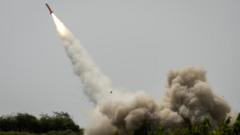Pope Leo XIV's inaugural Mass highlights the challenges and hopes for his papacy, amid significant global attention.
Pope Leo XIV's Inaugural Mass: A New Era for the Catholic Church

Pope Leo XIV's Inaugural Mass: A New Era for the Catholic Church
Leaders Gather in Vatican to Witness the First American Pope Take Office
Pope Leo XIV presided over his inaugural Mass on Sunday morning in St. Peter's Square, marking the commencement of his leadership over the Roman Catholic Church, which boasts a following of 1.4 billion believers. Present at this historic event were global leaders including U.S. Vice President JD Vance, Secretary of State Marco Rubio, and several prime ministers from around the world.
As the new pontiff, Leo—born Robert Francis Prevost in Chicago—delivered a heartfelt homily, expressing his gratitude for being chosen as a successor to St. Peter, the first leader of the Catholic Church. Dressed in traditional papal vestments, he prayed in Latin, seeking guidance as he steps into this significant role following the death of Pope Francis.
Before the Mass began, Pope Leo rode through St. Peter's Square in an open popemobile, enthusiastically greeted by cheering supporters who expressed their excitement for this monumental moment. His election as the first American to ascend to the papacy challenged past conventions, and many anticipate his approach to be more conciliatory compared to his predecessor.
Leo's inaugural speech underscored themes of unity and foresight as he acknowledged the pressing issues facing the modern world. Echoing sentiments from Pope Francis, he stressed the need for dialogue to resolve ongoing conflicts, particularly in Ukraine and Gaza, while voicing concerns regarding the rapidly advancing field of artificial intelligence.
Prominent attendees included leaders from various nations who sought to strengthen international relations. Vance and Zelensky engaged briefly in personal conversation, underscoring the diplomacy that underpins this significant moment in both church and state affairs.
Pope Leo's leadership style is expected to reflect his Augustinian roots, focusing on mission outreach and inclusivity, while aiming to address the complex dynamics and tensions currently affecting American Catholicism. His path forward remains to be fully defined, yet many see it as an opportunity for renewal within the Church. As the Mass concluded, attendees celebrated the rich traditions of the Catholic faith and the hopeful future under Leo XIV's guidance.
As the new pontiff, Leo—born Robert Francis Prevost in Chicago—delivered a heartfelt homily, expressing his gratitude for being chosen as a successor to St. Peter, the first leader of the Catholic Church. Dressed in traditional papal vestments, he prayed in Latin, seeking guidance as he steps into this significant role following the death of Pope Francis.
Before the Mass began, Pope Leo rode through St. Peter's Square in an open popemobile, enthusiastically greeted by cheering supporters who expressed their excitement for this monumental moment. His election as the first American to ascend to the papacy challenged past conventions, and many anticipate his approach to be more conciliatory compared to his predecessor.
Leo's inaugural speech underscored themes of unity and foresight as he acknowledged the pressing issues facing the modern world. Echoing sentiments from Pope Francis, he stressed the need for dialogue to resolve ongoing conflicts, particularly in Ukraine and Gaza, while voicing concerns regarding the rapidly advancing field of artificial intelligence.
Prominent attendees included leaders from various nations who sought to strengthen international relations. Vance and Zelensky engaged briefly in personal conversation, underscoring the diplomacy that underpins this significant moment in both church and state affairs.
Pope Leo's leadership style is expected to reflect his Augustinian roots, focusing on mission outreach and inclusivity, while aiming to address the complex dynamics and tensions currently affecting American Catholicism. His path forward remains to be fully defined, yet many see it as an opportunity for renewal within the Church. As the Mass concluded, attendees celebrated the rich traditions of the Catholic faith and the hopeful future under Leo XIV's guidance.





















